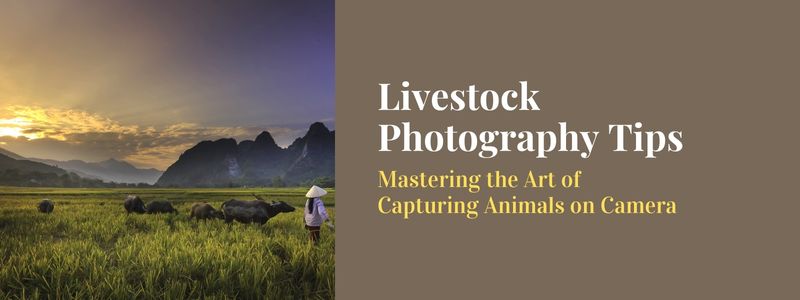Livestock photography is a challenging and rewarding field that requires a unique set of skills and knowledge. Whether you’re a professional photographer or an amateur, capturing animals on camera can be a challenging task. But with the right equipment, preparation, and techniques, you can create stunning and captivating images that showcase the beauty and personality of the animals you’re photographing. In this article, we’ll explore 15 essential tips for mastering the art of livestock photography.
15 Livestock photography tips –
Understanding the animals you will be photographing
Before you start taking pictures, it’s important to do your research and understand the animals you’ll be photographing. Learn about their characteristics and behaviours, this will help you anticipate what to expect and how to approach them.
Choosing the right equipment
Having the right equipment is essential for livestock photography. The type of camera and lens you use will greatly impact the final results of your images. A full-frame camera with a wide-angle lens can help you capture more of the animal’s environment and body. A telephoto lens will allow you to capture detailed shots of the animal’s face and other parts of the body. Additionally, lighting equipment, tripods and stabilizers are also important to have.
Planning the shoot location and time of day
Choosing the right location and time of day for your shoot is crucial for capturing the best images. Consider the lighting and background that will give you the best results. Research the location and plan the shoot accordingly, take into account the time of day when the lighting will be the best, and whether the animals will be active during that time.
Building trust and rapport with the animals
Building trust and rapport with the animals is essential for capturing natural and candid shots. Approach the animals calmly and quietly, and try to interact with them in a way that makes them feel comfortable. This can be achieved by talking to them softly, offering them treats, or spending time with them before the shoot. Building trust and rapport with the animals will help you to capture their true personalities and behaviours in your images.
Positioning and framing the animals
Positioning and framing the animals is crucial for capturing the best images. Pay attention to your positioning and framing, and experiment with different angles and perspectives to find the best shot. Consider the animal’s body language, and try to capture their expressions and movements in a way that showcases their personality and beauty. Be mindful of the background and the environment, and try to incorporate it in a way that enhances the overall image. Experiment with different compositions, such as the rule of thirds or leading lines, to add depth and interest to your images.
Capturing movement and action
Capturing movement and action in livestock photography is crucial to create dynamic and engaging images. To do this, use fast shutter speeds to freeze the movement of the animal, or use slower shutter speeds to capture the motion blur and create a sense of movement. Experiment with different shutter speeds to see how it affects your images.
Utilizing different angles and perspectives
To add depth and interest to your images, try different angles and perspectives. This can be achieved by shooting from above, below or at the animal’s level. Experiment with different angles and perspectives to find the best shot.
Basic editing techniques
Basic editing techniques such as adjusting the exposure, contrast, and saturation can make a big difference in the final image. Use editing software or outsource photo editing services to enhance the colors and contrast, to make the image more visually appealing.
Enhancing colors and contrast
Colors and contrast can be used to add an extra layer of interest to your images. Use editing software to enhance the colors and contrast to make the image more visually appealing. Experiment with different color schemes to see which one works best for the image.
Removing distractions and blemishes
Remove any distractions and blemishes that may be present in the image to make it more visually appealing. This can be done using editing software to crop or clone out any unwanted elements in the image.
Safety precautions when working with animals
When working with animals, it’s important to keep their welfare in mind. Take safety precautions and be aware of the animal’s behavior. Always be aware of your surroundings and the animal’s movements, to ensure the safety of both yourself and the animal.
Incorporating the animals’ environment into the photos
Incorporating the animals’ environment into the photos can help to tell a story and add context to the image. This can be achieved by including the animal’s surroundings, such as their habitat, in the image.
Shooting in different lighting conditions
Shooting in different lighting conditions can add an extra layer of interest to your images and help you to capture different moods and emotions. Experiment with different lighting conditions, such as shooting in low light or in direct sunlight, to see how it affects your images.
Using creative composition techniques
Using creative composition techniques such as the rule of thirds or leading lines can help to add interest and depth to your images. Experiment with different composition techniques to see which one works best for the image.
Continuously learning and experimenting with new techniques
Continuously learning and experimenting with new techniques is essential for any photographer, including those working with livestock. Whether it’s trying out a new editing technique or experimenting with different lenses, pushing yourself to try new things will help you to improve your skills and create better images.
Conclusion
Livestock photography is a challenging but rewarding field that requires a unique set of skills and knowledge. By following these 15 tips, you’ll be well on your way to capturing stunning and captivating images of animals. Remember to experiment with different techniques and keep practicing to improve your skills. Also, check out some additional resources for further learning. With the right equipment, preparation and techniques, you’ll be able to capture the beauty and personality of the animals you’re photographing.




